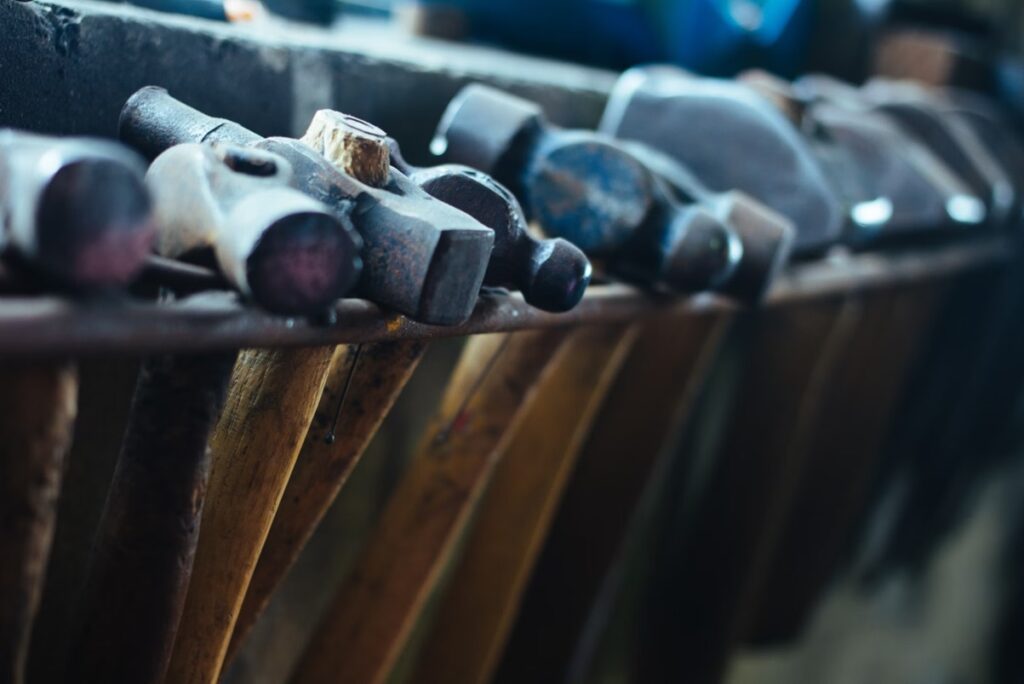Hammers are fundamental tools in any toolkit. Whether it’s hanging a picture, assembling furniture, or making small repairs, a hammer is essential. This article explores the versatility and importance of this tool in daily tasks.
In the world of tools, hammers stand out for their simplicity and effectiveness. From construction to carpentry, their presence is indispensable. The following paragraph will discover the different types and their specific uses, demonstrating why the hammer is a tool that cannot be missing in any home.
History and evolution of hammers
Hammers have a rich and varied history, dating back to prehistoric times. Originally made of stone, they were used to crack nuts and bones. Over time, they evolved into more sophisticated tools used in construction and metallurgy.
The evolution of hammers is closely linked to advances in materials and technologies. Metal hammers, introduced in the Bronze Age, marked a turning point in their development. Subsequently, the industrial revolution brought more specialized hammers, suitable for different professions and tasks.
This evolution continues to this day, with hammers designed for specific needs. From carpentry hammers to versions for masonry work, each type has unique characteristics adapted to its specific function.

Types of hammers and their uses
There are various types of hammers, each designed for a specific function. The claw hammer, for example, is ideal for driving and removing nails. On the other hand, the ball-peen hammer is used in metalworking to shape metal.
Rubber, wooden, or plastic hammers are perfect for tasks that require less force and more precision. These are used in tasks involving delicate materials, such as laying tiles or assembling furniture.
For heavier work, such as demolition, larger and more robust hammers, such as the sledgehammer, are used. This type of hammer is indispensable in construction and space renovation.
Maintenance and care of hammers
Adequate care of hammers ensures their durability and effectiveness. Good maintenance includes:
- Regular inspection: check the handle and head of the hammer to ensure they are securely attached.
- Cleaning: remove dust and dirt after each use.
- Proper storage: store hammers in a dry place to prevent rusting.
- Replacement or repair: if the handle is damaged or the head is worn, it is important to repair or replace the tool.
Tips for choosing the right hammer
Choosing the right hammer depends on the task at hand. For carpentry work, a claw hammer is the best choice. For masonry work, a sledgehammer or ball-peen hammer is recommended.
It is important to consider the weight of the hammer. A heavier hammer may be more effective but also more tiring to use. The comfort of the handle is also crucial, especially for prolonged work.
Safety in using hammers
Safety when using a hammer is crucial. Improper use can cause injuries. It is essential to always wear safety goggles to protect the eyes from debris and splinters.
It is recommended to wear gloves to improve grip and protect the hands. It is also important to maintain a balanced and secure posture when striking, avoiding straining the back or arms.
Innovations in hammer design
Currently, technological advances have led to the creation of more ergonomic and efficient hammers. There are models with anti-vibration handles that reduce fatigue and the risk of injuries from repetitive use.
Others have magnetic designs to hold nails, making tasks like nailing in hard-to-reach places easier. These innovations not only improve the user experience but also increase safety and precision in work.
Environmental impact and sustainability
It is important to consider the environmental impact of hammers, especially in terms of the materials used and their durability. High-quality hammers made with sustainable and recyclable materials are not only more durable but also more environmentally friendly.
Some brands are innovating in creating hammers with recycled or sustainable materials, which helps reduce the carbon footprint in tool production.
Hammers are fundamental tools in any toolkit. With a wide variety of types and uses, they adapt to almost any task, from carpentry to construction. By choosing the right hammer and providing proper care, this tool can be an invaluable ally in countless projects.
Source: MiMub in Spanish
